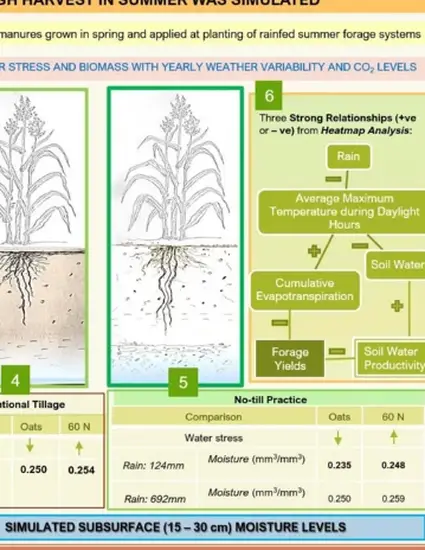
Conserving soil moisture is an important safeguard for drought resiliency in crop production for the U.S. Southern Great Plains. Conservation tillage and cover crops are tools that can provide cover and protect soils and conserve moisture. We assessed variations in simulated water-stress for sorghum-sudangrass (Sorghum bicolor (L.) Moench x Sorghum sudanense (P.) Stapf.) grown for forage, and examined impacts generated by tillage systems (no-till, NT and conventional, CT) and three spring crops grown for green manures (oat, field pea, grass pea) compared to a control (spring fallow and 60 kg inorganic nitrogen ha−1). We calibrated and validated CERES-Sorghum model before simulating the biomass and agroecosystem functions (crop genetics and management, and soil). Seasonal analysis method was adopted to predict biomass and other water parameters during 2006 to 2015 and available soil water in two contrasting growing seasons (2012, dry; 2015, wet) in central Oklahoma, USA. We modified genotype-specific files and parameters of the ‘Residue’ file to simulate change in available moisture by soil layer. Sorghum-sudangrass produced slightly higher amounts of biomass under NT across years and green-manure crops. Weather variables significantly influenced sorghum-sudangrass during growing seasons. Green manures increased (P < 0.05) biomass production (229 to 328 kg ha−1 yr−1), irrespective of tillage system; 63% of production was explained by form of tillage. Water stress on production was affected by growing seasons but not by nitrogen treatments. More water was available in subsurface soils (15–30 cm) across years under CT and was more uniform across treatments. Water availability under NT differed among years and varied by treatments within years; oat green-manure crops reduced available soil-moisture. Heatmap analyses showed strong negative effects on soil water is from cumulative evapotranspiration, which had strong positive relationships with maximum temperatures during daylight hours and solar radiations. Management with the combination of green manure and NT or CT were found as better practice to deal with water-stress and produce better than CT-60N. Overall, green-manure crops were an effective strategy for conserving soil moisture under CT, and NT during wetter growing seasons, and could be beneficial in conserving soil water in sorghum-sudangrass systems. Graphical Abstract: [Figure not available: see fulltext.]
Available at: http://works.bepress.com/reshmi-sarkar/25/